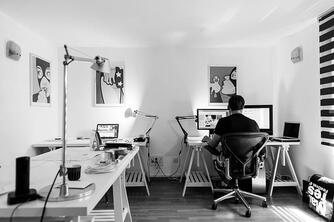 You may now be returning to the workplace after a long two years of absence. You may be pleased to get back to the office, or maybe not so much. You liked the flexibility of working from home but now you are called back. Whether you like going back to the workplace or not, you will experience the push and pull of change. A quote by the Greek philosopher Heraclitus comes to mind. It is as true today as it was thousands of years ago, “the only constant is change.” Life changes, workplaces change, organizations change, sometimes slowly and sometimes very quickly. One of the keys to meeting change head on is to realize that is it not necessarily the change that happens that is important, but how you react to it. To cope effectively with changes, you need to develop key skills that will help you adapt and grow into your new reality. Below are seven ways to do just that. Respect Change Respecting change means accepting that change happens and striving to do what needs to be done to move through the change process. Finding balance and understanding between living with and adjusting your thinking to meet the challenges of change is a key coping skill. Accepting changes shows your strength. You may not like the changes that are taking place but understanding what you can accept versus what you can’t control helps you cope. The next step in meeting changes within the workplace is finding your comfort zone. This usually means clarifying for yourself what you have control over and searching out how the change will help you become better at what you do. Most people don’t like changes, but they can push you beyond your normal boundaries and help you grow. Give It Time Forever is a long time. Most changes don’t last forever because another change takes their place. One coping skill to deal with change is to remind yourself that your current situation can change too. When you learn to respect changes, you build the skill of moving yourself through them to a new and better situation. It’s meeting Heraclitus’s philosophical dictum head on -‘the only constant is change”. Both good and bad changes can happen slowly or unexpectedly. Either way, remember to frame the change as a part, not all, of your life. You don’t know how the next change will affect you, and it may be better. When you work on yourself to meet any kind of change, give yourself time to learn and grow. Learn from Mistakes There are a lot of stops and starts in organizational change. And, sometimes mistakes are made. You may be a person who wants to get on with it. Yet, the change may not go as smoothly as planned. It’s easy to become impatient when you want to make a change – or to adjust to change. Another key coping skill is to learn from the mistakes so that you can construct a better way to handle it. Don’t look at mistakes to find fault. And for goodness sakes don’t approach them with a mindset of failure. See them as mistakes that can be corrected. Use them to learn new skills and better ways of dealing with changes. Mistakes should be a teacher, not a barrier. Learning from your mistakes in the workplace helps you move past them and make better choices about how you will deal with future changes. Practice Self-Care Practicing self-care is also a key coping skill to deal with changes. Self-care includes taking the time to focus, build, and balance your mental and emotional health. The stronger your mental and emotional health is, the better you will be able to deal with changes. Self-care can include meditation, relaxing activities, or simply time spent pursuing hobbies and interests you have. Practices such as these outside of the workplace can help you deal with changes within the workplace. Even in the workplace you can slow your pace down by taking deep breaths and spending five minutes relaxing your brain with a quick meditation (see the 3 Minute Mental Break here). Taking the time to focus on yourself helps you build the mental and emotional strength needed to remain calm during changes and prepares you to make changes that will improve your life. Practice Gratitude When you struggle through the change process and discover what you can control, you will also learn to understand that changes can be opportunities. These opportunities can help you reach your personal goals by increasing your knowledge, seeking help from others, or committing to a course of action. When you see changes as opportunities, you become grateful for the chance to move forward. The skill of being grateful for even difficult changes helps improve your mindset. With a healthy, positive mindset, you will deal more effectively with changes now and into the future. Use Humor Scientists have studied the effects of humor on people’s physical, mental, and emotional health. Humor is a key coping skill for dealing with change. Laughing, smiling, and seeing the humor in situations can lower blood pressure, decrease stress, and boost your mood. Humor can put changes into perspective and remind you that not every change is as bad as you may think. Humor can also help you connect with other people who can support you during changes. Stay Physically Healthy When you are experiencing changes, you need to stay physically healthy. Poor health adds stress that can make changes more difficult. Needing to deal with health problems can steal your time and focus away from dealing with changes. Eating right, getting enough sleep, and exercising your body will help you deal with changes. In conclusion You can see by how this article unfolded that changes you face in the workplace are fundamentally how you deal with change in all aspects of your life. Approaching workplace change with a sense of respect, gratitude and humor, a recognition that it could really be a time for personal growth, an attitude of learning from setbacks and mistakes, and a need to keeping healthy and looking after yourself, will help you become the best version of yourself. Use these key coping skills and it doesn't matter how big or small, good or bad the change is you can deal with it more effectively. Thank you for reading and as always take care, be safe and continue your journey of self-discovery. Richard F.
0 Comments
 What is with this topic? It seems odd to talk about a workplace culture when you are running a homebased business with few if any employees. Lets talk about this. Workplace culture usually means a collection of attitudes, beliefs and behaviors that are found within a regular work environment and is normally found in workplaces outside the home. Healthy workplace cultures align employee behaviors with the vision, mission values, and goals of the company, while considering the overall wellbeing of individuals. Thriving companies have work cultures that recognize employees successes and provide rewards when they do well. This suggests that they are led by leaders and managers who continually look for positive attributes of everyone within the organization and foster the use of their talents. When the work culture is positive everyone pulls together, collaborates, coordinates work, and has positive relationships. Workplace culture is often described as the personality and character of the company. It is what makes the company unique in the eyes of the employees, those looking to join it, and the people it serves. So how does this apply to a homebased solopreneur enterprise? Solopreneurs operate out of their home, often without employees, and are self-managed. Well there is more to this then initially meets the eye. These days we have two major shifts taking place in our workplace communities as a result of the recent pandemic. First, we are seeing a more flexible workplace where employees split their work between home and the outside workplace; and secondly, there are a number of people who have left the corporate world and have started their own business from home. This article concentrates on the latter situation, the solopreneur homebased business. How do they create a homebased culture? The Homebased Business Culture For those who are operating a homebased business my personal research as led me to believe that the owners of these businesses need to take a hard look at how they approach their business from a business perspective. By that I mean they need to be clear about their own business vision, mission, goals and values. Many do not take the time to sort this out. They jump right into starting a business without clearly identifying where they want to take the business and how the business should operate. They lack systems, processes and strong time management skills. Homebased Business Culture Problems Here are six problem areas I have found when working with solopreneurs:
What is this saying to solopreneurs? It seems they are caught on a treadmill. They are busy but going nowhere. Not only that they are burning themselves out. A Way Out For You The only employee of a homebased business is most often you. You are the owner and the doer in the business. So if you are the only employee what are you doing to yourself? What kind of environmental culture are you creating so that you not only survive but more importantly thrive in your business? We know that the solopreneur failure rate can be reduced when owners have effective training, coaches and mentors. This has been proven time and time again. Our firm has also proved this. Our experience showed that 80% of those who started a business were still in business after five years when they had access to business training, coaches and mentors. It is clear that if you as a solopreneurs want to build a personal business culture where you don’t crash and burn then you need to carefully consider:
In conclusion yes, solopreneurs can create an environment where they are driven by purpose and strategic direction based on meaningful principles and values. As they do, they will be seen by their colleagues and customers as leaders in their field of expertise and will travel on a path that points in the direction of success. And, they will have a more balanced lifestyle giving time for those things that are most important to them. They will be building a satisfying culture for themselves. If you find you and your homebased business is not progressing in the direction you would like then contact me for a free personal consultation to determine the best course of action for you. Just click the button below. Thank you for reading and as always stay safe, keep well and continue becoming the best version of yourself. Richard Fontanie  It seems that adults are subject to stress no matter where they are at: on the job, at home, in social gatherings and even on vacation. Unfortunately technology is feeding into the stress meter. So much so that it is one of the leading causes of anxiety overload we experience on a daily basis. In fact we can now positively say that a slave attachment to social media can be addictive. Recent studies are finding a direct link between productivity performance issues and the way people exploit social media worldwide. It may be fun to browse our friends’ posts or be tickled with the latest funny YouTube video or just taking a minute to glance at Tic Toc, but the truth is all that time spent on social media translates into lost productivity. Now don’t get me wrong. I’m not talking about the positive impact social media can have, both on our work and business. What I am talking about is the misuse of social media in the workplace. Here are some examples. Delaying Pending Work There is no doubt many people put off meeting deadlines because of the work piled up on their desk or virtual desktop. We have a host of excuses as to why this may occur. Some legitimate while others not so legitimate. There are legitimate excuses that may relate to illness, children, and sickness within the family. Then there are not so legitimate reasons such as procrastination, lack of an action plan or lack of setting priorities. We fall to the favorite excuse of many, ‘there is just not enough time to finish the work.” Several years ago we could blame other factors for delaying the work we do, however, technology has now become an example of how lifestyle improvements can work both ways: technology can help us get the job done more efficiently or postpone it for an incredible amount of time. One of the first things we can do about this problem is to accept our responsibilities and acknowledge that social media does play a role in the way we deal with our work. Unless our job requires us to interact with social media we are wasting energy and that impacts the amount of stress we feel because we are not managing our time well. Playing to Insecurity Many people like to compare themselves to their friends. We used to call this “keeping up with the Jones’". Now we have social media which has opened the door to a large number of new friends. Some of whom we really don’t know, but we add them anyway to our list. These so called friends are nothing other than virtual acquaintances but their influence affects us anyway. Not only do we compare ourselves to the friends we know, we now compare ourselves to the friends we don’t know, setting the bar even higher than it was before. In essence it seems we don’t want to appear ‘boring’ in comparison to our friends. We see them going on exotic trips, perhaps having more money than us they take extended vacations to places we can only dream about going to, or they post pictures of their latest purchase giving the impression that they are highflyers. The reality is, however, that many social media users portray a status they don’t have. The bottom line here is not to accept everything you see on social media as fact and more importantly avoid comparing yourself with others. Recognize your own importance and self-worth and the merits of your potential. Masking Mental Health Some mental illness can now be easily diagnosed such as schizophrenia or bipolar disorder. People with these conditions are not defined by them but they are seen as an illness, just as a physical ailment doesn’t define the person who is physically ill. There are mental health conditions that keep cropping up at different times in our history. Today, one of them may be a condition which we have masked as ‘shyness’. Now shyness can reflect a quiet and withdrawn character trait but some people hide behind the term ‘shy’ or ‘shyness’ as a way to cover up a fear if missing out. FOMO or the “Fear Of Missing Out” is a term used in this connection. What happens in cases like this is that people will tend to blame their lack of social skills by interacting with a growing number of “friends” online. This allows them to mask mental health issues by living in denial. In other words, since I interact with people online, I have no relational or social disorders such as “shyness”. People in the medical profession are beginning to recognize a growing trend of people seeking medical help which is directly related to our current use of social media. Perhaps an antidote to this is to tune out online activity and tune into offline relationships. The Results of Stress When we don’t take stress seriously it can be the main cause of a long list of life-threatening conditions. The Stressology 100 Learning Guide – Mind, Body and Emotions, points out that stress can cause intermittent anxiety attacks to chronic conditions such as gastritis, heart diseases, diabetes, and depression. The list covers almost every aspect of everyday life. Why does stress trigger havoc in our lives? The culprit falls to an imbalance produced by stressful conditions which in turn triggers massive amounts of cortisol – also known as the “stress hormone” – which directly impacts sleep patterns, elevated blood pressure, weight gain, hyperglycemia, and cognitive performance issues such as memory loss or disfunction; this is a cycle that repeats itself over and over again unless we decide to do something about it. So, what can we do about it? Well the good news is there are ways to deal with deep levels of stress through therapy groups, individual counselling, and even self-help approaches. The first step is to recognize that one has a problem and then move towards a healing process. Now it may not be easy, and one should not expect immediate results. But when attachment to social media reaches the addiction level then like most addictions, it can be healed but it will take time to both deal with it appropriately and adapt to a more normal social outcome. Awareness, Determination, perseverance and support are keys to resolution and the road to a more satisfying lifestyle. Thank you for reading, and as always stay safe, be well and continue becoming the best version of yourself. Richard Fontanie Further Resources Anxiety and Social Media Use : https://www.psychologytoday.com/us/blog/digital-world-real-world/202002/anxiety-and-social-media-use What is Social Media Addiction, https://www.addictioncenter.com/drugs/social-media-addiction/ Stressology 100 and 200 – Stress Care For Today. And excellent resource for the cause and remedy for stress. Found in the FM Storefront. Shyness and Social Media use: https://www.sciencedirect.com/science/article/abs/pii/S074756321930158X It’s not personal article written by Sherry Knight, Dimension11
It's not personal! Really? When you hear someone say to you, “…, it’s not personal.” Does your brain automatically think, gee, this isn’t about me, it’s about the world at large? I doubt it! It’s like when Sam says to Georgia, “It’s not personal, but your work is the pits!” Now tell me, are you going to hear that statement and say, “Oh, that’s not a slam against me?” Of course not! IT IS PERSONAL! And that is because we are emotionally involved in our work – after all, it is where we spend a third of our day. Being emotionally involved makes you a great employee and if you aren’t emotionally involved in your work then you are in the wrong job or perhaps even the wrong organization. This saying got a lot of attention in the film, The Godfather when Michael Corleone develops his plan to kill his rival mob boss and the corrupt police chief. Sonny, his brother, laughs it off lets Michael know that it’s business and he is taking it personally. Michael Corleone replies “It’s not personal Sonny. It’s strictly business!” Fortunately, we understand that Michael Corleone was wrong! Yes, totally wrong! It stings, it hurts when that statement is used, and it usually is, to remind us that something is not right about us. And that’s the truth. So, if you want to protect yourself around those words that you hear, consider this:
Whether at work or at home or in the community take the time to never allow it to be, “It’s not personal!” Everything is personal – everyone cares! Be sure to be the kind of friend and co-worker or manager that you want, not one that puts you down and makes you feel like you don’t matter. Each morning, start with your own growth – a daily plan including: gratitude, meditation, exercise and a focus on what the result of the day is. Being emotionally strong allows you to let those who say, “It’s just business!” not leave an impression (on) your psyche. Try it! Why write an article of this nature when most businesses are closed due to COVID-19. Perhaps this is a good time to reflect on your workplace culture practices and make suggestions to change the way you approach your organization and the people within it. Brian Kristofek once said, “Being a great place to work is the difference between being a good company and great company.” The success of your company or organization depends largely upon your ability to develop a positive company culture. How you develop or adjust policies, procedures, and processes to meet the needs of a rapidly changing future has a profound impact on the atmosphere, values, structure, and morale of people within your organization. So what can you do to foster a positive company culture? Well that is what The Workplace Culture video found in FORTIS MEMBERSHIP is all about. This 30-minute video covers a wide range of topics that will assist you in developing a positive culture among your team and within your workplace. The following are five suggestions from that video. 1. Assess Your Current Culture Assessing your company culture is easy when you are just starting out. After all, culture starts with the very first person you hire. You begin setting your company culture right away by setting out the type of person and values that suites you and your company. However what happens when your company is already well established? What do you do then? How do you maintain and improve your existing company or organizational culture? Basically you will need to reassess and define your company culture if you want to see some improvements. Here are some simple steps to understand, change and improve your existing culture. a) Evaluate your on-boarding process. If your hiring and training methods are antiquated consider transitioning into more personalized, open and participatory processes. b) Determine whether the leadership is fluid and agile. Your organization will have difficulty moving forward if your leadership team is static and resistant to change. c) Review your organization’s recognition and rewards program. Give employees several options on how they want to be recognized and rewarded. d) Assess the interaction among team members and the interaction among teams. The goal is to establish relations that will pave the way for effective collaboration. 2. Know and identify the values that underpin your business operations. If you don’t do this it won’t be easy to identify what you want your company culture to look like. Some questions you should ask yourself when uncovering your company values are:
3. Institutionalize the culture After you have identified the kind of culture you want and need, commit the policies and processes to reinforce the new culture. Make sure these policies and processors are scalable so that they can meet growth and change. You can do this by engaging a number of employees in the hiring process, essentially involving them in determining if a new hire is a good fit with the culture. Other things you can do are:
4. Build Trust The foundation to every company success is employee trust. It is unfortunate that a lot of major companies have high levels of alienation and distrust among leaders and employees. Communication issues are often the culprit in this regard. The foundation to building strong trust within an organization is always good communication. Make sure you:
5. Reduce Micromanagement. Micromanagement holds employees back. In smaller organizations bureaucracy and micromanagement can almost be eliminated. The barriers between management and owner in smaller organizations can be encouraged. A flat organizational model can work when there is a close connection between managers and employees. Bureaucracy is reduced when there is direct access to the leadership team or business owner. Make everyone feel that they belong and that they are capable of handling and finishing their own work. When employees own their own work they feel valued and have a sense of belonging. Thank you for Reading, Richard Fontanie PS. If you are a member of FORTIS MEMBERSHIP go to Masterclasses and Training. The video "Workplace Culture" is under the heading LEADERMANAGER. if you are not a member consider joining HERE. |
Categories
All
Archives
January 2024
|
Photo from TheBosque


 RSS Feed
RSS Feed
